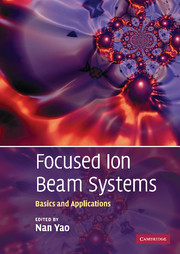Book contents
- Frontmatter
- Contents
- List of contributors
- Preface
- 1 Introduction to the focused ion beam system
- 2 Interaction of ions with matter
- 3 Gas assisted ion beam etching and deposition
- 4 Imaging using electrons and ion beams
- 5 Characterization methods using FIB/SEM DualBeam instrumentation
- 6 High-density FIB-SEM 3D nanotomography: with applications of real-time imaging during FIB milling
- 7 Fabrication of nanoscale structures using ion beams
- 8 Preparation for physico-chemical analysis
- 9 In-situ sample manipulation and imaging
- 10 Micro-machining and mask repair
- 11 Three-dimensional visualization of nanostructured materials using focused ion beam tomography
- 12 Ion beam implantation of surface layers
- 13 Applications for biological materials
- 14 Focused ion beam systems as a multifunctional tool for nanotechnology
- Index
- References
4 - Imaging using electrons and ion beams
Published online by Cambridge University Press: 12 January 2010
- Frontmatter
- Contents
- List of contributors
- Preface
- 1 Introduction to the focused ion beam system
- 2 Interaction of ions with matter
- 3 Gas assisted ion beam etching and deposition
- 4 Imaging using electrons and ion beams
- 5 Characterization methods using FIB/SEM DualBeam instrumentation
- 6 High-density FIB-SEM 3D nanotomography: with applications of real-time imaging during FIB milling
- 7 Fabrication of nanoscale structures using ion beams
- 8 Preparation for physico-chemical analysis
- 9 In-situ sample manipulation and imaging
- 10 Micro-machining and mask repair
- 11 Three-dimensional visualization of nanostructured materials using focused ion beam tomography
- 12 Ion beam implantation of surface layers
- 13 Applications for biological materials
- 14 Focused ion beam systems as a multifunctional tool for nanotechnology
- Index
- References
Summary
Overview of imaging using FIB
Scanning electron microscopes (SEM), transmission electron microscopes (TEM), and scanning TEM (STEM) have been used for structural observation of microdevices, advanced materials, and biological specimens. In recent years, a gallium (Ga) focused ion beam (FIB) has been used for preparing their cross-sectional samples [1, 2, 3, and Chapter 9 in this book]. Here, FIB works both as a milling beam and as a probe for a scanning ion microscope (SIM). SIM images are used during the whole milling processes, that is, drawing the milling area, milling monitoring, confirmation of the final milling, and observation of the FIB milled sections of interest. As SIM image resolution has been improved and about 5 nm is achievable at present, SIM observation has been increasingly used in place of SEM observation when there is no especial need for high image resolution.
However, we have found that the properties of SIM images are somewhat different to SEM images. For example, SIM and SEM images of identical FIB milled cross sections are shown in Figures 4.1(a)–(d): (a) and (c) show a solder (Pb-Sn) on copper (Cu) and (b) and (d) show a Si device (static random access memory) [4]. Black-and-white contrast among materials is opposite between the SIM and SEM images. In addition, grain contrast (or channeling contrast) can be observed more clearly in the SIM image and its contrast is sometimes stronger than the material contrast. Figure 4.2 shows SIM and SEM images of FIB cross-sectioned human hair [5].
- Type
- Chapter
- Information
- Focused Ion Beam SystemsBasics and Applications, pp. 87 - 125Publisher: Cambridge University PressPrint publication year: 2007
References
- 2
- Cited by



